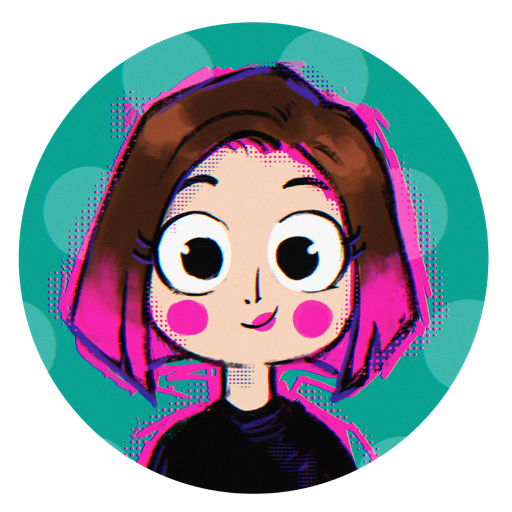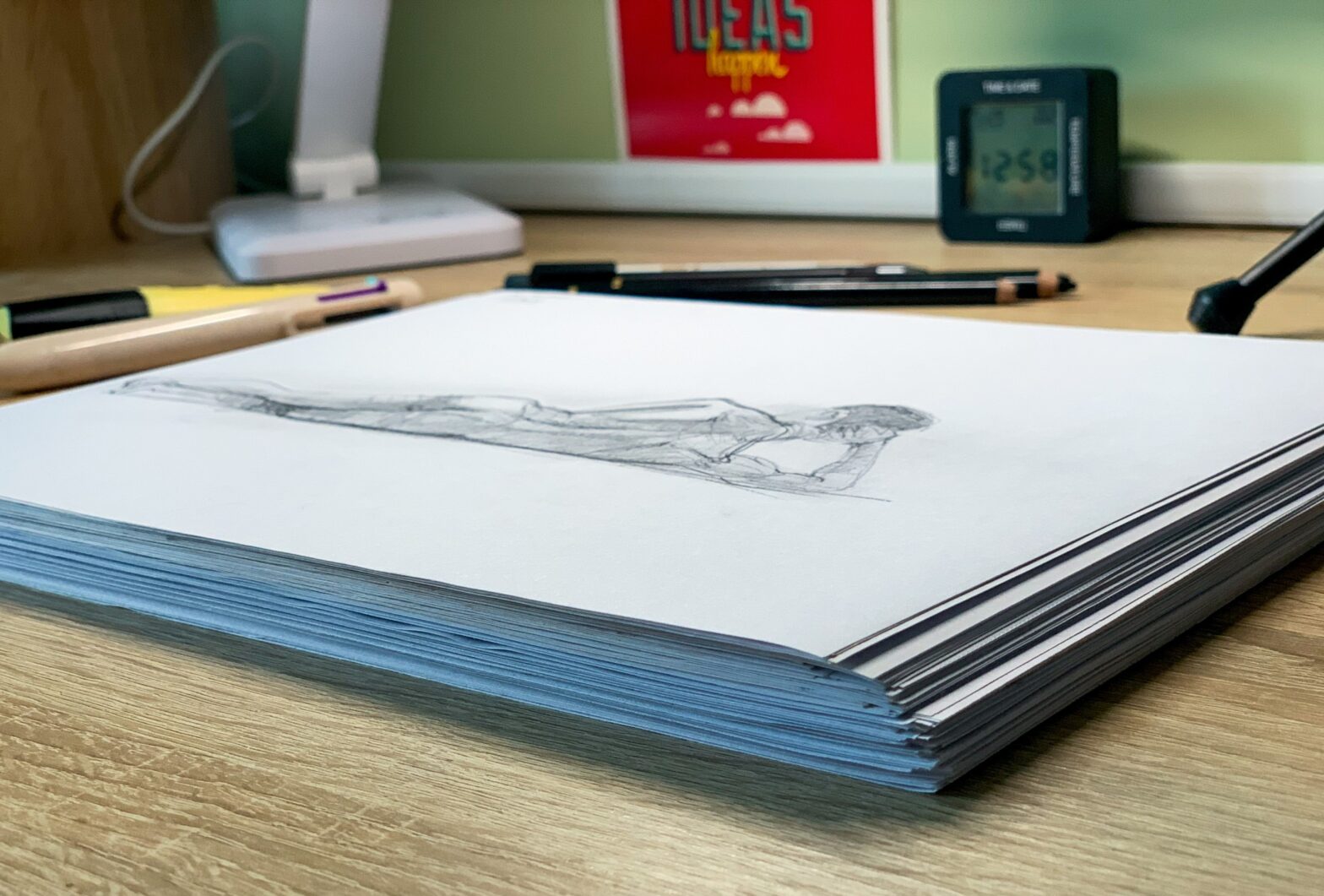In April 2021 I gathered all my courage and organizational skills and presented my personal drawing challenge which I named #DRAWGESTURESWITHNADINE to my Instagram and Twitter audience.
This blog post is a retrospective where I write about how I’ve got an idea to organize a drawing challenge. I walk through weekly reports reviewing and analyzing experience I’ve gained. I also describe tough moments of discouragement and approaches I used to deal with them. I share methods that helped me to stay productive and motivated during this challenging period of my life that I intentionally created on my own.
__________
The aims of this challenge were testing my human figure drawing skills, updating my portfolio with fresh drawings, revealing gaps in my knowledge of human anatomy, setting new study goals and considering steps for their achieving.
I liked the idea to call this practice “a challenge” and invite other people to join it. Such attitude should have helped me to feel responsible about this project and to create fresh content almost every day during one month.
And I wasn’t mistaken.
The focus of my attention has been shifted to the process instead of the result. This allowed me to create content regularly and didn’t worry about how “pretty” and “good looking” my Instagram feed would look. I was just posting updates based on the challenge schedule.
Everyone who wanted to join the challenge could do so by using #drawgestureswithnadine hashtag. I don’t have big audience, thus I didn’t count that there would be any participant, honestly. But I was happy to notice that there were people who decided to join and keep me a company.
The plan was as follows.
I was going to draw 1 hour a day, 5 days a week during 4 weeks (20 days). By the end of the challenge it was supposed to be around 400 sketches. (SPOILER: I made 399)
Since I was not able to organize visiting life drawing classes, I planned to use online resources with photo references of models. As for drawing media, I wanted to go with traditional tools shifting media whenever I feel I want to try a new one.
The start of the drawing challenge was announced on April 5, 2021.
Here’s how it was going.
Week 1
Planned timing: 20 mins / sketch
Planned amount of sketches: 15 / week
During the first week (5 days) I was planning to draw 20 minutes poses during 1 hour. By doing so, I should have had 3 sketches per day and 15 sketches by the end of the week.
I started with the planned timing but decided to shorten drawing time to 15 minutes per pose. I noticed that 15 minutes were ideal time for me to transfer postures’ proportions and the feel of movement, to add simple shadowing and to have more or less good looking sketch. The rest 5 minutes were spent on tracing shadows which was a bad idea because tracing, without good understanding of the subject of tracing, made my drawings deteriorate. Therefore, I reduced time to keep myself comfortable with what I was doing and wrote down the first point that I need to work on.
I also noticed that I was bad (at least, not as good as I thought I am) at drawing complex poses such as sitting and lying poses. Also poses with a body placed in perspective were hard for me, therefore I skipped such postures for the whole challenge. Besides, I felt uncertain about models placed under contrast lighting, thus skipping contrast and dark references as well.
My general experience from the first week of the challenge was very positive even though I realized that there’re a lot of aspects I’m not good at. I was thrilled to start the challenge and to discover a giant room for improvement. I was inspired and wanted to draw more poses but stopped myself from doing extra drawings for the sake of saving enthusiasm for the next weeks.
Actual timing: 20-15 mins / sketches
Actual amount of sketches: 16 / week
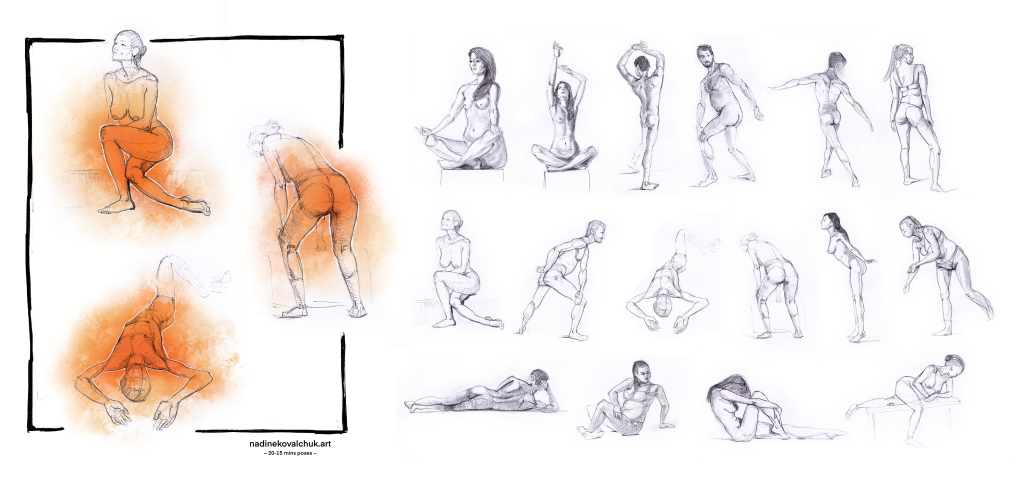
Week 2
Planned timing: 10 mins / sketch
Planned amount of sketches: 30 / week
The plan for this week was to start sketch on Monday and to have 30 sketches by Friday. To achieve this goal I should have drawn 6 sketches per day 10 minutes each. I started doing so.
It took time for me to realize that the same approach I used for drawing 20 minutes sketches didn’t work for 10 minutes sketches. I had to figure out how to simplify and adapt my drawing technique to the new timing.
6 sketches per hour appeared to be a challenge to my cognitive abilities. By the middle of a drawing session the level of my attention span gradually decreased. My mind refused to concentrate and it became hard analyzing models’ body structures and transferring them on paper. Eventually, I decided to switch to 5 mins poses earlier than planned because I felt tired and wanted to feed my brain with a new problem set.
For this drawing challenge I bought some new traditional tools one of which was Koh-I-Noor Progresso Woodless Graphite Pencil, 8B Degree. I used this pencil the whole previous week and it became one of my favorite traditional drawing tools.
Another drawing tool that I bought was sepia. I tried drawing one sketch with sepia but it didn’t work out as I don’t have experience in working with such soft material.

I also tried to draw with charcoal pencil (yet another purchase) and I liked how some drawings came out. But I felt that I didn’t use full potential of this media because I don’t have experience in drawing with charcoal either.

Many years ago I bought sanguine drawing sticks which had been waiting for their finest hour to be used. I thought why not to try them now?
Although, sketches drawn with sanguine turned out pretty good and I liked how this media was lying in my hands, my preferred drawing material remained that Koh-I-Noor woodless graphite 8B pencil.
Actual timing: 10-5 mins / sketch
Actual amount of sketches: 29 / week
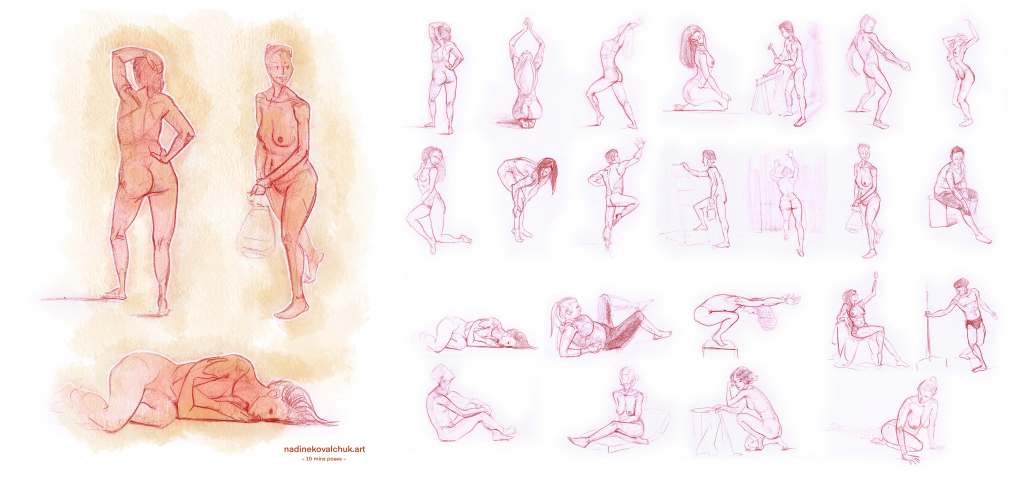
Week 3
Planned timing: 5 mins / sketch
Planned amount of sketches: 60 / week
The 3rd week of the drawing challenge was the hardest one. With challenge ongoing, it became trickier for me to juggling other spheres of my life. I stopped eating regularly, doing exercises and taking shower. The result of such attitude to my body didn’t keep me waiting long. By the end of the week I felt sick and urgently needed to change the situation.
The main reason why I became unbalanced was constant self-criticism. This week my Inner Critic was especially cruel and harsh to me. I thought that I was doing everything wrong, that I was just losing my time with this challenge and the result wouldn’t worth my efforts.
What helped me not to give up and quit is a detailed plan that I wisely prepared for myself a month earlier. Written to-do list helped me to overcome moments of discouragement. No matter how bad my emotional state was, I was just doing what I planned. I allowed myself to make adjustments on the fly to keep myself entertained.
By the end of the 3rd week I wanted to add some variety into models as well as into drawing tools. I was surprised to notice that my brain got used to proportions and muscle structures of the models that I had been drawing for 2 weeks by now and it’s not easy to switch to other models quickly. If I allowed myself to learn new body shapes with, at least, 20 minutes timing, the idea of adding new models would probably work out. But prolonging time back to 20 minutes wasn’t in my plan, thus I switched back to the familiar models and continued with 5 minutes poses.
By the end of the 3rd week I got comfortable with complex poses (but still avoided contrast lighting) and switched to 2-3 minutes sketches.
Actual timing: 5-2 mins / sketch
Actual amount of sketches: 54 / week

Week 4
Planned timing: 1 min / sketch
Planned amount of sketches: 300 / week
If the 3rd week was the hardest week, the last week of the challenge appeared to be my favorite one.
This week I was going to draw fast poses, therefore I prepared drawing templates for the party. It was a simple 4×3 squares grid on an A4-sized piece of paper.

This grid became a good drawing guide that helped me to use drawing space efficiently. It also helped me to keep high level of concentration as I didn’t have to change a piece of paper every minute (yes, changing sheets also takes mental resources, as appeared).
The shorter your drawing timing is, the faster you should switch to a new drawing. You don’t have much time for making big expressive lines, if your plan is making 60 drawings 1 minute each. I intentionally limited the size of 1 minute sketch to a small square in order to keep myself more concentrated on the drawing process instead of being focused on changing sheets for a new pose every minute.

Reviewing 300 sketches that I was able to produce (and I’m very proud that I drew so much that week!), I find that my sketches are dynamic and lines are confident. If you take a closer look at the drawings, they will seem pretty simple but that’s the goal – being able to show body movement in a few lines.
Sketching became an automatic action so that I was able to have small talks while drawing with my husband.
I tried to do 30 seconds poses but didn’t feel comfortable with this timing.
This challenge revealed that for now my longest / shortest comfortable time is 15 / 1 mins.
Actual timing: 1 min / sketch
Actual amount of sketches: 300 / week
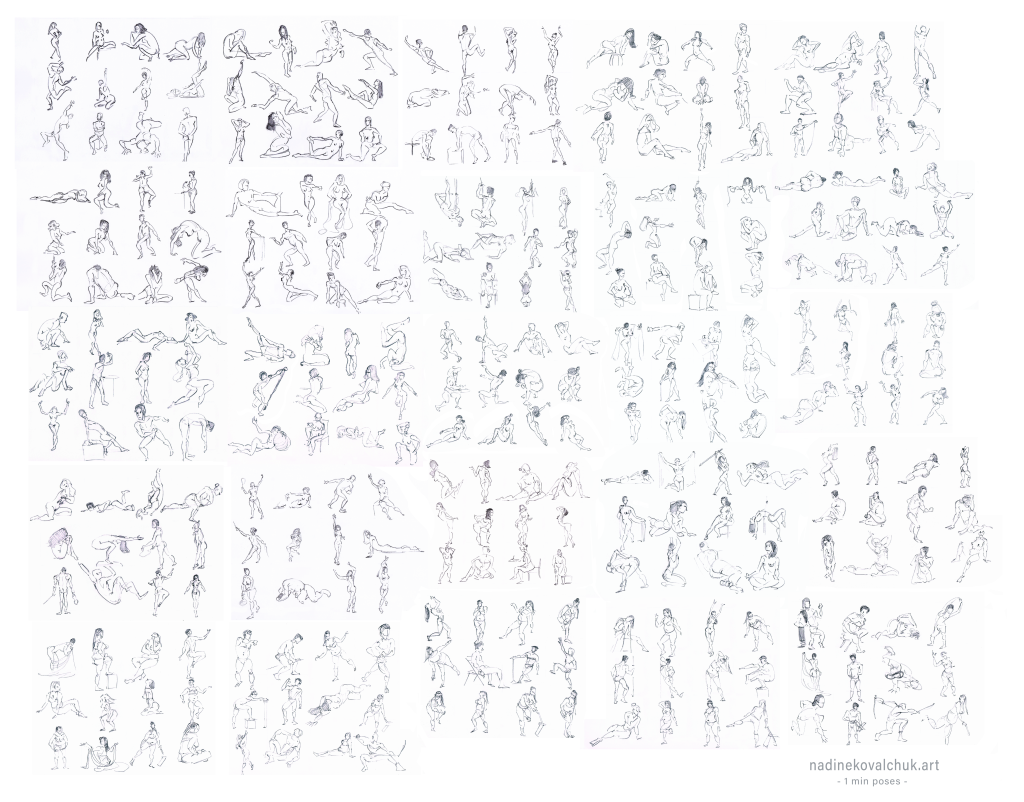
WHAT HAVE I LEARNED FROM THE CHALLENGE
- Regularity is a key to success.
«I only write when I am inspired. Fortunately, I am inspired at 9 o’clock every morning.» —William Faulkner
Everybody says that. The more you practice, the better you’ll be at what you’re practicing. Having this knowledge is one thing, but going through the process of earning this knowledge is another thing.
My practice sessions have always been chaotic and spontaneous rather than structured and regular. Of course, I didn’t see the progress.
I knew I need to practice every day to be more efficient in improving my skills but I didn’t understand the importance of such attitude.
The challenge helped me to reveal why it’s important to be regular in practicing. Every new drawing session I felt that I was becoming more confident in figure drawing. Also my drawing time has speeded up which means that now I can do more work in a shorter period of time. And this means I became more valuable professional on the market.
It’s not a secret that sportsmen should be training every day to stay fit. The same applies to every skill. Either it’s sport or drawing or learning a foreign language.
A rule of thumb: 15 mins of practice every day is better than practicing 8 hours once a month.
2. If you have a plan, 50% of work is done.
Try to build realistic plans. Don’t overestimate your abilities.
If you feel inspired and want to do more than planned, stop yourself. Stay “hungry” and save your enthusiasm for the next time.
A great benefit of having a plan of action is that it becomes a safety bag which will help you to pass through harsh moments of self-criticism, demotivation and doubting, if you face them. You won’t need to waste precious mental resources on setting new tasks for yourself in the moments of devastation. Just check the plan and do what you’ve already planned.
3. Improvisation is possible, if you have a plan.
Many people will disagree with the idea of having a plan saying that it becomes a limitation for their creativity. And I absolutely agree that strict following a to-do list becomes boring very soon.
When a wave of inspiration hits you, you face big temptation to catch this wave and surf it. However, you never know for how long this inspirational wave will stay with you. And this is when your plan becomes handy. It’ll show you a direction for swimming when the wave goes away.
If you get bored, try to adjust what you’ve planned to keep yourself entertained.
I changed drawing media and timing to do so.
4. You shouldn’t be naturally good at everything. Give yourself time for developing new skills.
It might seem obvious but for a perfectionist like me it’s hard to accept that I’m not perfect at something naturally.
The understanding that such mindset is super silly, doesn’t help me to stop criticizing myself all the time during the studying process, unfortunately. It’s hard to continue doing what you do being under pressure. The harder it becomes when you realize that it’s *you* who puts you under pressure.
Breathe in. Breathe out.
Give yourself allowance to be imperfect and keep developing in your own pace.
Remember, it’s better to do something than nothing.
WHATS NEXT? FUTURE GOALS AND A PLAN.
That was my experience from a 20-days drawing challenge.
Human figure drawing is a lifelong learning and there always will be a room for improvement. However, having a tangible goal to work towards will keep you focused and motivated.
Therefore, here’s my next plan.
1. Take a figure drawing class.
The next time I’ll go through constructive anatomy study, I’m going to take an online drawing class with an instructor. I want to receive feedback and recommendation on my work from an artist with greater experience than mine. Now when I know my weak points, I’ll be able to choose a proper course and focus on things I want to improve.
2. Organize short but regular sessions of figure drawing.
In order to keep my skills on the same level at least, I have to continue drawing on a daily basis. 15 mins per day is a good start. I would love to practice more, but fortunately or not, current tempo of my life doesn’t allow me to do so. Going to deal with available amount of time. 15 mins are better than 0 🙂
3. Study drawing with soft media (sepia, charcoal pencil).
When your passion becomes your occupation, it’s easy to forget how you originally enjoyed what you used to do for free. I miss this childlike joy from drawing process and I want to bring it back to my life. And I believe that learning how to use new media will help me with that.
__________
This was the first time when #DRAWEGESTURESWITHNADINE challenge took place online. It wasn’t popular among artistic community, and I wasn’t counting it will be so this time. I’ll absolutely launch it again, even though I don’t know when I am ready for it.
If you’re an artist or a person who wants just to have fun with human figure drawings, feel free to use hashtag any time so that I can find your work and feature it in my Instagram stories. Don’t wait for me to announce a new start. You’re always free to join the party.
Feel free to use this material for educational purposes under the Creative Commons Attribution-NonCommercial-NoDerivatives 4.0 International License. For other uses please contact me through email business@nadinekovalchuk.art or contact form.
If you find inaccuracy or if you have a question, please let me know in comments or email at website@nadinekovalchuk.art
